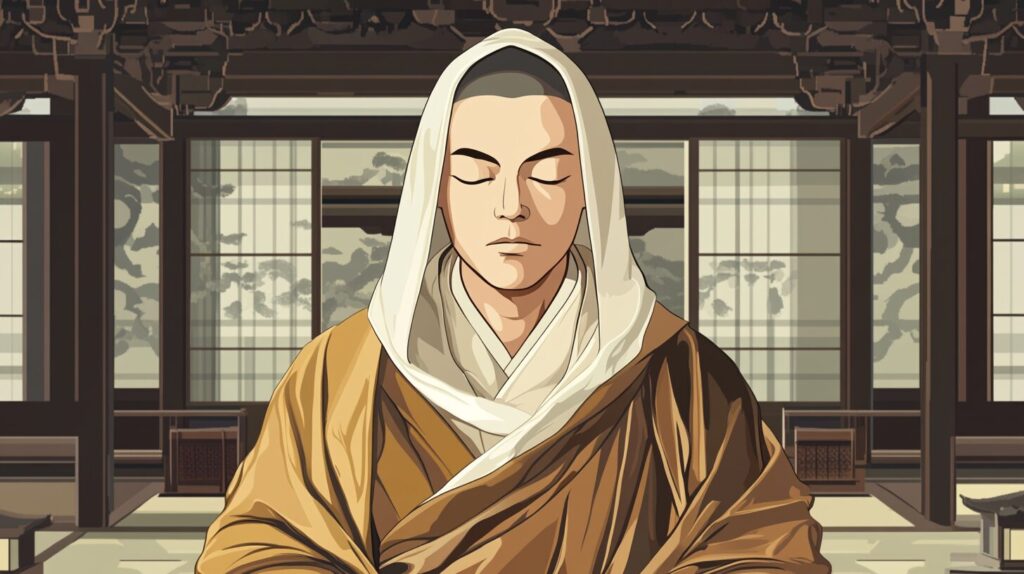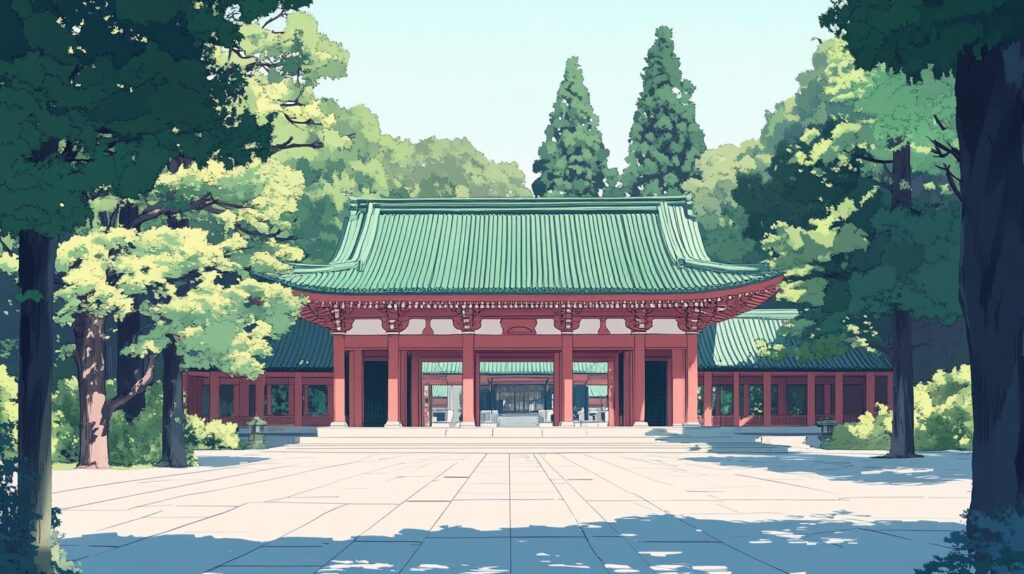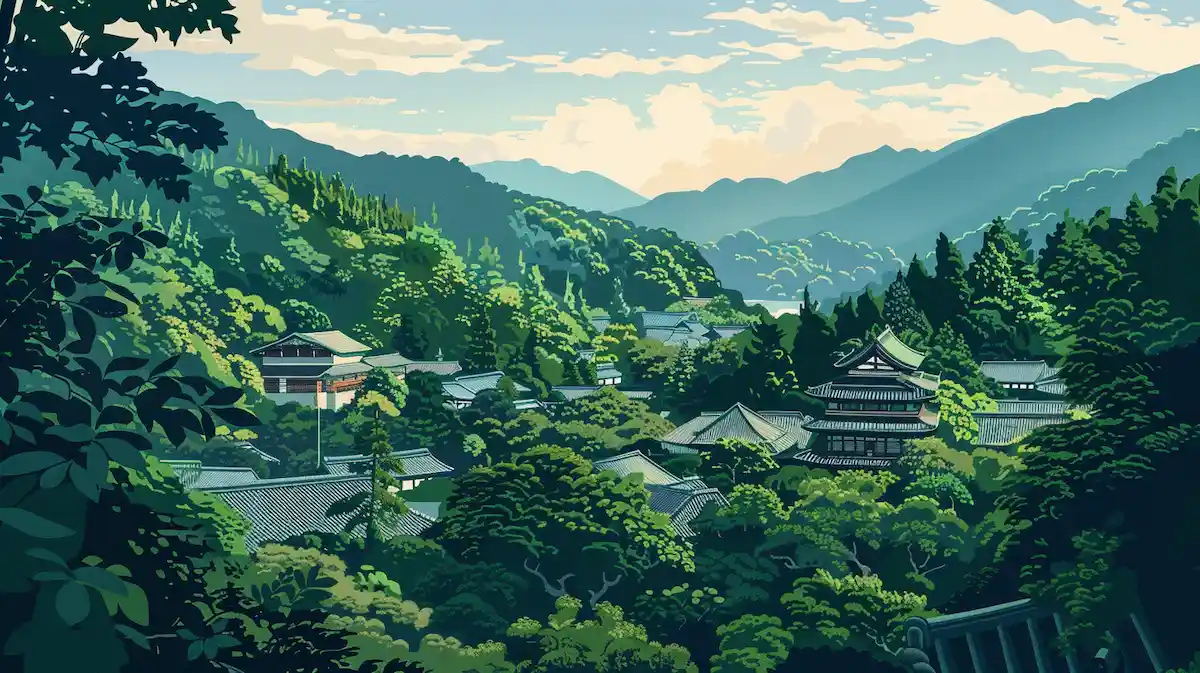最澄を英語で説明・紹介するための基本情報と、英会話に役立つ表現をシンプルでわかりやすい英語で紹介します。
英会話ダイアローグ・概要・10の質問を通して、最澄に関する英語表現を学びます。
英語
英会話ダイアローグを読む前に知っておくと良い前提知識と情報です。
- 最澄とは
- 最澄(766または767年 – 822年) は、日本の仏教僧で天台宗 の開祖
- 比叡山延暦寺を建て、日本仏教の中心地を作った
- 後の日本仏教(浄土宗・浄土真宗・禅宗・日蓮宗など)に大きな影響を与えた
- 最澄の主な業績
- 中国から天台宗を日本に持ち帰った:
- 804年に遣唐使として中国(唐)へ渡った
- ほとんどの僧は数年滞在するが、最澄はわずか8か月で学び終え、日本に帰国
- 延暦寺を創建:
- 延暦寺は多くの有名な僧侶を輩出し、日本仏教の発展に大きく貢献
- 「すべての人は仏になれる」と説いた:
- 当時の仏教は、一部の特別な人(貴族や僧侶)だけのものと考えられていた
- 最澄は 「すべての人に仏性があり、仏になれる」 という平等な考えを広めた
- 大乗戒壇設立への挑戦:
- 当時、日本の僧侶は奈良の東大寺で「小乗仏教の戒律」を受ける必要があった
- 最澄は、「大乗仏教の新しい戒律」を作り、日本独自の僧侶教育を確立しようとした
- 奈良仏教勢力の反対で、生前には実現しなかったが、彼の死後7日後に大乗戒壇の設立が許可された
- 中国から天台宗を日本に持ち帰った:
- 最澄の有名な言葉
- 「一隅を照らす」:
- 「自分のいる場所で最善を尽くせば、世界はより良くなる」 という意味
- 現代でも、社会貢献や仕事の姿勢として使われる言葉
- 「忘己利他」:
- 「自分のことを忘れて、他人のために尽くす」 という意味
- 最澄の仏教の考え方をよく表している
- 「一隅を照らす」:
- 最澄の影響を受けた僧侶たち
- 法然:浄土宗の開祖
- 親鸞:浄土真宗の開祖
- 道元:曹洞宗の開祖
- 日蓮:日蓮宗の開祖
2人が最澄について話しています。
最澄の中国への渡航、天台宗を日本に広めたこと、比叡山延暦寺の創建、有名な言葉「一隅を照らす」などを話題にしています。
会話 / dialogue

Hey Key, I’ve been reading about Buddhism in Japan, and I came across this monk named Saichō. Have you heard of him?

Of course! Saichō was one of the most important Buddhist monks in Japanese history. He founded the Tendai school and built Enryaku-ji on Mount Hiei.

Yeah, I read that! But what made him so special?

Well, for starters, he brought Tendai Buddhism from China to Japan. In 804, he traveled to China as part of a diplomatic mission and studied at Mount Tiantai.

I heard that most monks stayed in China for years, but Saichō finished in just eight months! That’s crazy.

Exactly! He was incredibly focused. He didn’t just learn Tiantai teachings; he also studied Zen and Esoteric Buddhism.

So when he came back, he started spreading these teachings in Japan?

Yes, and he built Enryaku-ji, which became Japan’s most important Buddhist training center. Many famous monks, like Hōnen, Shinran, Dōgen, and Nichiren, studied there before founding their own schools.

Wow, so he influenced all of them? That’s impressive.

Definitely. And another reason he was special is his idea of equality. He believed that all people have the potential to become Buddhas.

That sounds very different from traditional Buddhism at that time.

It was! He also wanted to change how monks were ordained. Back then, monks had to follow strict Hinayana precepts from Tōdai-ji in Nara, but Saichō wanted a Mahayana ordination platform instead.

Let me guess—people didn’t like that idea?

Exactly! The powerful Nara Buddhist schools strongly opposed it. Saichō kept fighting for it, but sadly, he passed away before it was approved.

That’s so sad… so his dream never came true?

Actually, it did! Just 7 days after his death in 822, the government finally approved his idea.

Oh, that’s amazing! He didn’t live to see it, but his efforts still made a difference.

That’s right. One of his most famous sayings is “Illuminate One Corner” (Ichigu wo Terasu). It means “Do your best where you are, and you can make the world better.”

I love that! It’s such a simple but powerful idea.

That’s why he’s still admired today. He wasn’t just a monk—he was a visionary who changed Japanese Buddhism forever.

I think I want to visit Enryaku-ji now. It must be an incredible place.

You definitely should! Standing there, you can really feel his legacy. Let’s go together sometime!
概要 / Overview
「最澄」について、理解を深めるための「英語での概要」です。
最澄

Who Was Saichō?
Saichō (766 or 767 – 822) was a famous Buddhist monk in Japan. He founded the Tendai school and built Enryaku-ji Temple on Mount Hiei. His ideas changed Japanese Buddhism and influenced many later monks.
Studying in China
In 804, Saichō traveled to China with a government mission. He studied Tiantai Buddhism at Mount Tiantai. He also learned Zen Buddhism and Esoteric Buddhism (Taimitsu). Usually, monks stayed in China for many years, but Saichō finished his studies in only 8 months and returned to Japan.
Building Enryaku-ji
After returning to Japan, Saichō built Enryaku-ji Temple on Mount Hiei. This temple became the most important Buddhist training center in Japan. Many famous monks, such as Hōnen, Shinran, Dōgen, and Nichiren, studied there before starting their own schools.
The Idea of Equality
Saichō believed that all people can become Buddhas. At that time, many believed that only monks or nobles could reach enlightenment. Saichō’s idea was different—he taught that everyone has Buddha nature and can achieve enlightenment.
Changing Buddhist Rules
In Saichō’s time, monks in Japan had to follow Hinayana Buddhist rules at Tōdai-ji Temple in Nara. However, Saichō wanted a new system based on Mahayana Buddhism. He asked the government to create a Mahayana ordination platform, but the Nara Buddhist schools strongly opposed it.
Saichō’s Death and Legacy
Sadly, Saichō died in 822, before his ordination platform was approved. However, 7 days after his death, the government finally accepted his idea. His teachings continued to influence Japanese Buddhism for centuries.
Famous Words: “Illuminate One Corner”
One of Saichō’s most famous sayings is “Ichigu wo Terasu” (Illuminate One Corner). It means, “Do your best in your own place, and you can make the world better.” This idea is still popular today.
Conclusion
Saichō was a visionary monk who introduced Tendai Buddhism to Japan, built Enryaku-ji, and promoted equality in Buddhism. His influence can still be seen in Japanese Buddhism today.
10の質問 / 10 questions
「最澄」について、理解を深めるための「英語での10の質問」です。
1: Who was Saichō?
Saichō was a Japanese Buddhist monk who founded the Tendai school and built Enryaku-ji Temple on Mount Hiei. He played an important role in shaping Japanese Buddhism.
2: When did Saichō travel to China, and why?
In 804, Saichō traveled to China as part of a government mission. He went to study Tiantai Buddhism and also learned Zen and Esoteric Buddhism.
3: What is Enryaku-ji?
Enryaku-ji is a Buddhist temple built by Saichō on Mount Hiei. It became the most important training center for Japanese monks and influenced many later Buddhist schools.
4: What was Saichō’s idea about equality in Buddhism?
Saichō believed that all people have the potential to become Buddhas. This was different from the traditional belief that only monks or nobles could reach enlightenment.
5: What is the Tendai school?
The Tendai school is a branch of Mahayana Buddhism that Saichō introduced to Japan. It emphasizes the teachings of the Lotus Sutra and includes elements of Zen and Esoteric Buddhism.
6: What was Saichō’s relationship with Kūkai?
Saichō and Kūkai, the founder of the Shingon school, were friends at first. However, they later disagreed about Buddhist teachings, and their friendship ended.
7: Why did Saichō want a new ordination system?
In his time, monks had to follow strict Hinayana Buddhist precepts at Tōdai-ji in Nara. Saichō wanted a Mahayana ordination platform that focused on compassion and enlightenment.
8: What happened to Saichō’s Mahayana ordination plan?
Saichō died before it was approved, but just 7 days after his death in 822, the government accepted his idea, changing Japan’s Buddhist system.
9: What is the meaning of Saichō’s famous saying, “Illuminate One Corner”?
It means that people should do their best in their own place to make the world a better place. This idea is still respected today.
10: How did Saichō influence later Japanese Buddhism?
Many famous Buddhist leaders, such as Hōnen, Shinran, Dōgen, and Nichiren, studied at Enryaku-ji before founding their own schools. Saichō’s teachings shaped Japanese Buddhism.

和訳付
会話 / dialogue

Hey Key, I’ve been reading about Buddhism in Japan, and I came across this monk named Saichō. Have you heard of him?
ねえキー、日本の仏教について読んでいたら、最澄っていうお坊さんを見つけたんだ。知ってる?

Of course! Saichō was one of the most important Buddhist monks in Japanese history. He founded the Tendai school and built Enryaku-ji on Mount Hiei.
もちろん!最澄は日本の歴史の中でも特に重要な仏教僧の一人だよ。天台宗を創始して、比叡山に延暦寺を建てたんだ。

Yeah, I read that! But what made him so special?
そう、それは読んだ!でも、最澄の何がそんなに特別だったの?

Well, for starters, he brought Tendai Buddhism from China to Japan. In 804, he traveled to China as part of a diplomatic mission and studied at Mount Tiantai.
まず、彼は中国から天台宗を日本に持ち帰ったんだ。804年に遣唐使の一員として中国へ渡り、天台山で学んだんだよ。

I heard that most monks stayed in China for years, but Saichō finished in just eight months! That’s crazy.
ほとんどの僧は何年も中国に滞在するって聞いたけど、最澄はたった8か月で学び終えたんだって?すごいな。

Exactly! He was incredibly focused. He didn’t just learn Tiantai teachings; he also studied Zen and Esoteric Buddhism.
その通り!彼はものすごく集中力があったんだよ。天台の教えだけじゃなく、禅や密教も学んだんだ。

So when he came back, he started spreading these teachings in Japan?
それで、日本に戻ってからは、それらの教えを広めたんだね?

Yes, and he built Enryaku-ji, which became Japan’s most important Buddhist training center. Many famous monks, like Hōnen, Shinran, Dōgen, and Nichiren, studied there before founding their own schools.
そうだよ。それで延暦寺を建てて、日本の仏教の中で最も重要な修行の場になったんだ。法然、親鸞、道元、日蓮といった有名な僧侶たちも、そこに学んでからそれぞれの宗派を開いたんだよ。

Wow, so he influenced all of them? That’s impressive.
ええっ、それじゃあ、彼ら全員に影響を与えたってこと?すごいな。

Definitely. And another reason he was special is his idea of equality. He believed that all people have the potential to become Buddhas.
そうなんだよ。彼が特別だったもう一つの理由は、平等の考え方を持っていたこと。彼は、すべての人に仏になる可能性があると信じていたんだ。

That sounds very different from traditional Buddhism at that time.
それって、当時の仏教とはかなり違った考え方だったんじゃない?

It was! He also wanted to change how monks were ordained. Back then, monks had to follow strict Hinayana precepts from Tōdai-ji in Nara, but Saichō wanted a Mahayana ordination platform instead.
そうなんだ!さらに、彼は僧侶の受戒の制度も変えようとしたんだ。当時、僧侶は奈良の東大寺で厳しい小乗仏教の戒律を受けなければならなかった。でも、最澄は大乗仏教の受戒制度を作ろうとしたんだよ。

Let me guess—people didn’t like that idea?
もしかして… その考えは受け入れられなかった?

Exactly! The powerful Nara Buddhist schools strongly opposed it. Saichō kept fighting for it, but sadly, he passed away before it was approved.
その通り!奈良の強い仏教勢力が猛反対したんだ。それでも最澄は最後まで戦ったけど、残念ながら、彼が亡くなる前には承認されなかったんだ。

That’s so sad… so his dream never came true?
それは悲しいな… つまり、彼の夢は叶わなかったってこと?

Actually, it did! Just 7 days after his death in 822, the government finally approved his idea.
実は叶ったんだよ!最澄が亡くなったちょうど7日後の822年に、政府がついに彼の提案を認めたんだ。

Oh, that’s amazing! He didn’t live to see it, but his efforts still made a difference.
ええっ、それはすごい!彼自身は見ることができなかったけど、彼の努力がちゃんと実を結んだんだね。

That’s right. One of his most famous sayings is “Illuminate One Corner” (Ichigu wo Terasu). It means “Do your best where you are, and you can make the world better.”
その通り。彼の有名な言葉の一つに「一隅を照らす」があるよ。「自分がいる場所で最善を尽くせば、世界をより良くできる」っていう意味なんだ。

I love that! It’s such a simple but powerful idea.
すごくいい言葉だね!シンプルだけど、とても力強い考え方だ。

That’s why he’s still admired today. He wasn’t just a monk—he was a visionary who changed Japanese Buddhism forever.
だからこそ、今でも尊敬されているんだよ。彼は単なる僧侶じゃなくて、日本の仏教を永遠に変えた先見の明を持つ人だったんだ。

I think I want to visit Enryaku-ji now. It must be an incredible place.
なんだか、延暦寺に行きたくなってきたよ。きっとすごい場所なんだろうな。

You definitely should! Standing there, you can really feel his legacy. Let’s go together sometime!
絶対に行くべきだよ!そこに立つと、最澄の遺産を実感できるはず。今度一緒に行こう!
概要 / Overview
最澄

Who Was Saichō?
Saichō (766 or 767 – 822) was a famous Buddhist monk in Japan. He founded the Tendai school and built Enryaku-ji Temple on Mount Hiei. His ideas changed Japanese Buddhism and influenced many later monks.
最澄とは誰か?
最澄(766年または767年 – 822年)は、日本の有名な 仏教僧 でした。彼は 天台宗 を創設し、比叡山に延暦寺 を建てました。彼の考え方は日本の仏教を変え、多くの後の僧侶に影響を与えました。
Studying in China
In 804, Saichō traveled to China with a government mission. He studied Tiantai Buddhism at Mount Tiantai. He also learned Zen Buddhism and Esoteric Buddhism (Taimitsu). Usually, monks stayed in China for many years, but Saichō finished his studies in only 8 months and returned to Japan.
中国での学び
804年、最澄は政府の遣唐使とともに 中国 へ渡りました。彼は 天台山 で 天台宗 を学びました。また、禅宗と密教(台密) も学びました。通常、僧侶は中国に数年間滞在しますが、最澄は わずか8か月で学び終え、日本に帰国しました。
Building Enryaku-ji
After returning to Japan, Saichō built Enryaku-ji Temple on Mount Hiei. This temple became the most important Buddhist training center in Japan. Many famous monks, such as Hōnen, Shinran, Dōgen, and Nichiren, studied there before starting their own schools.
延暦寺の建立
日本に戻った後、最澄は 比叡山に延暦寺 を建てました。この寺院は 日本で最も重要な仏教の修行場 となりました。法然、親鸞、道元、日蓮 などの有名な僧侶たちは、ここで学んでから、それぞれの宗派を開きました。
The Idea of Equality
Saichō believed that all people can become Buddhas. At that time, many believed that only monks or nobles could reach enlightenment. Saichō’s idea was different—he taught that everyone has Buddha nature and can achieve enlightenment.
平等の考え方
最澄は、すべての人が仏になれる と考えていました。当時は、多くの人が「悟りを開けるのは僧侶や貴族だけ」と信じていました。しかし、最澄は異なる考えを持ち、「すべての人には仏性があり、悟りに到達できる」 と説きました。
Changing Buddhist Rules
In Saichō’s time, monks in Japan had to follow Hinayana Buddhist rules at Tōdai-ji Temple in Nara. However, Saichō wanted a new system based on Mahayana Buddhism. He asked the government to create a Mahayana ordination platform, but the Nara Buddhist schools strongly opposed it.
仏教の制度改革
最澄の時代、日本の僧侶は 奈良の東大寺 で 小乗仏教の戒律 を受ける必要がありました。しかし、最澄は 大乗仏教 に基づく新しい制度を作りたいと考えました。彼は政府に 大乗戒壇 の設立を求めましたが、奈良の仏教勢力は強く反対しました。
Saichō’s Death and Legacy
Sadly, Saichō died in 822, before his ordination platform was approved. However, 7 days after his death, the government finally accepted his idea. His teachings continued to influence Japanese Buddhism for centuries.
最澄の死と遺産
残念ながら、最澄は 822年 に亡くなり、彼の戒壇の設立が承認される前に 命を落としました。しかし、彼の死後7日後に、政府は ついに彼の提案を受け入れました。彼の教えは、その後何世紀にもわたって日本の仏教に影響を与え続けました。
Famous Words: “Illuminate One Corner”
One of Saichō’s most famous sayings is “Ichigu wo Terasu” (Illuminate One Corner). It means, “Do your best in your own place, and you can make the world better.” This idea is still popular today.
有名な言葉:「一隅を照らす」
最澄の最も有名な言葉の一つは、「一隅を照らす」 です。この言葉の意味は、「自分がいる場所で最善を尽くせば、世界をより良くできる」 というものです。この考え方は、現代でも多くの人に影響を与えています。
Conclusion
Saichō was a visionary monk who introduced Tendai Buddhism to Japan, built Enryaku-ji, and promoted equality in Buddhism. His influence can still be seen in Japanese Buddhism today.
まとめ
最澄は 先見の明を持つ僧侶 であり、日本に 天台宗 を広め、延暦寺 を建て、仏教の 平等の考え方 を広めました。彼の影響は、今も日本の仏教に残っています。
10の質問 / 10 questions
1: Who was Saichō?
最澄とは誰ですか?
Saichō was a Japanese Buddhist monk who founded the Tendai school and built Enryaku-ji Temple on Mount Hiei. He played an important role in shaping Japanese Buddhism.
最澄は日本の仏教僧で、天台宗を創設し、比叡山に延暦寺を建てました。彼は日本仏教の発展において重要な役割を果たしました。
2: When did Saichō travel to China, and why?
最澄はいつ中国へ渡り、なぜ行ったのですか?
In 804, Saichō traveled to China as part of a government mission. He went to study Tiantai Buddhism and also learned Zen and Esoteric Buddhism.
804年、最澄は遣唐使の一員として中国へ渡りました。彼は天台宗を学ぶために行き、禅や密教も学びました。
3: What is Enryaku-ji?
延暦寺とは何ですか?
Enryaku-ji is a Buddhist temple built by Saichō on Mount Hiei. It became the most important training center for Japanese monks and influenced many later Buddhist schools.
延暦寺は最澄が比叡山に建てた仏教寺院です。日本の僧侶にとって最も重要な修行の場となり、後の多くの仏教宗派に影響を与えました。
4: What was Saichō’s idea about equality in Buddhism?
最澄の仏教における平等の考え方は何ですか?
Saichō believed that all people have the potential to become Buddhas. This was different from the traditional belief that only monks or nobles could reach enlightenment.
最澄は、すべての人には仏になる可能性があると信じていました。これは、僧侶や貴族だけが悟りを開けるという従来の考え方とは異なっていました。
5: What is the Tendai school?
天台宗とは何ですか?
The Tendai school is a branch of Mahayana Buddhism that Saichō introduced to Japan. It emphasizes the teachings of the Lotus Sutra and includes elements of Zen and Esoteric Buddhism.
天台宗は、最澄が日本に広めた大乗仏教の一派です。この宗派は法華経の教えを重視し、禅や密教の要素も取り入れています。
6: What was Saichō’s relationship with Kūkai?
最澄と空海の関係はどのようなものでしたか?
Saichō and Kūkai, the founder of the Shingon school, were friends at first. However, they later disagreed about Buddhist teachings, and their friendship ended.
最澄と真言宗の開祖である空海は、最初は友人でした。しかし、後に仏教の教えについて意見が対立し、彼らの友情は終わりました。
7: Why did Saichō want a new ordination system?
最澄はなぜ新しい受戒制度を求めたのですか?
In his time, monks had to follow strict Hinayana Buddhist precepts at Tōdai-ji in Nara. Saichō wanted a Mahayana ordination platform that focused on compassion and enlightenment.
彼の時代、日本の僧侶は奈良の東大寺で厳格な小乗仏教の戒律を受ける必要がありました。最澄は、慈悲と悟りを重視した大乗仏教の受戒制度を求めました。
8: What happened to Saichō’s Mahayana ordination plan?
最澄の大乗受戒制度の計画はどうなりましたか?
Saichō died before it was approved, but just 7 days after his death in 822, the government accepted his idea, changing Japan’s Buddhist system.
最澄はこの制度が承認される前に亡くなりましたが、822年の彼の死後わずか7日後に、政府は彼の考えを受け入れ、日本の仏教制度が変わりました。
9: What is the meaning of Saichō’s famous saying, “Illuminate One Corner”?
最澄の有名な言葉「一隅を照らす」の意味は何ですか?
It means that people should do their best in their own place to make the world a better place. This idea is still respected today.
これは、「自分のいる場所で最善を尽くせば、世界をより良くすることができる」という意味です。この考え方は今でも尊重されています。
10: How did Saichō influence later Japanese Buddhism?
最澄は後の日本仏教にどのような影響を与えましたか?
Many famous Buddhist leaders, such as Hōnen, Shinran, Dōgen, and Nichiren, studied at Enryaku-ji before founding their own schools. Saichō’s teachings shaped Japanese Buddhism.
法然、親鸞、道元、日蓮などの有名な仏教指導者は、それぞれの宗派を創設する前に延暦寺で学びました。最澄の教えは日本仏教の形を作るのに大きな影響を与えました。

words & phrases
英会話ダイアローグと関連情報に出てきた単語・フレーズです(例文は各3つ)。

for starters : フレーズ
意味: まず第一に、手始めに。Used to introduce a first point or reason in a discussion.
(最澄の特別な点を説明する際の最初のポイントを紹介する表現)
例文:
- For starters, we need to understand Saichō’s journey to China.
「まず最初に、最澄の中国への旅を理解する必要があります。」 - For starters, this temple is one of the most important in Japan.
「まず第一に、この寺院は日本で最も重要なものの一つです。」 - For starters, his teachings influenced many Buddhist leaders.
「手始めに、彼の教えは多くの仏教指導者に影響を与えました。」
ordain : 動詞
意味: (僧侶や聖職者を)任命する、叙任する。To officially make someone a priest or religious leader.
(最澄が新しい大乗仏教の受戒制度を提案したことに関連して使用)
例文:
- He was ordained as a Buddhist monk at a young age.
「彼は若い頃に仏教僧として叙任されました。」 - The temple ordains new monks every year.
「その寺院では毎年新しい僧を叙任します。」 - Saichō wanted to ordain monks under the Mahayana system.
「最澄は大乗仏教の制度の下で僧侶を叙任したいと考えていました。」
precept : 名詞
意味: (道徳的・宗教的な)戒律、教訓。A rule or principle that guides behavior, especially in religion.
(最澄が奈良仏教の小乗戒律に代わる新しい大乗戒を提案した際に使用)
例文:
- Buddhist monks must follow strict precepts.
「仏教僧は厳格な戒律を守らなければなりません。」 - The precepts of Mahayana Buddhism emphasize compassion.
「大乗仏教の戒律は慈悲を強調しています。」 - Saichō challenged the old precepts of the Nara schools.
「最澄は奈良仏教の古い戒律に異議を唱えました。」
ordination : 名詞
意味: (僧侶や聖職者の)叙任、受戒。The process of officially becoming a religious leader.
(最澄が新しい大乗戒壇を設立しようとしたことを表す際に使用)
例文:
- The ordination of monks takes place at the temple.
「僧侶の受戒は寺院で行われます。」 - Saichō wanted a new ordination system for Tendai monks.
「最澄は天台宗の僧侶のために新しい受戒制度を求めました。」 - His idea for Mahayana ordination was accepted after his death.
「彼の大乗仏教の受戒の考えは、彼の死後に認められました。」
visionary : 名詞・形容詞
意味: 先見の明がある人(名詞)、未来を見据えた(形容詞)。Someone who has original ideas about the future.
(最澄が日本仏教を大きく変えた革新者であったことを表す際に使用)
例文:
- Saichō was a visionary who changed Japanese Buddhism.
「最澄は日本仏教を変えた先見の明を持つ人物でした。」 - His visionary ideas helped Buddhism evolve.
「彼の革新的な考えは仏教の発展を助けました。」 - Many people still respect Saichō as a visionary.
「多くの人々が今でも最澄を先見の明を持つ人物として尊敬しています。」
詳細情報 / Further Info
関連記事(比叡山延暦寺)

